ICT50115 BSBMGT608 Assessment: Innovation and Improvement Strategies
VerifiedAdded on 2022/08/25
|12
|2609
|13
Homework Assignment
AI Summary
This assignment, completed by a student, addresses key aspects of innovation and improvement within an organizational context. The first part consists of answers to written questions, exploring concepts such as the definition and types of innovation, key performance indicators, risk mitigation strategies, supplier evaluation, performance management tools, and contingency planning. The second part presents a transition plan report, focusing on critical organizational systems and processes, appropriate assessment tools, macro and market trends, technological opportunities, and the need for an innovative system. The report also covers advancing learning and creative culture, reward and recognition systems, risk and cost analysis, and idea management. The plan includes a transition schedule, communication strategies, and a training plan. The assignment provides a comprehensive overview of managing innovation and implementing change within an organization, particularly in an educational setting.
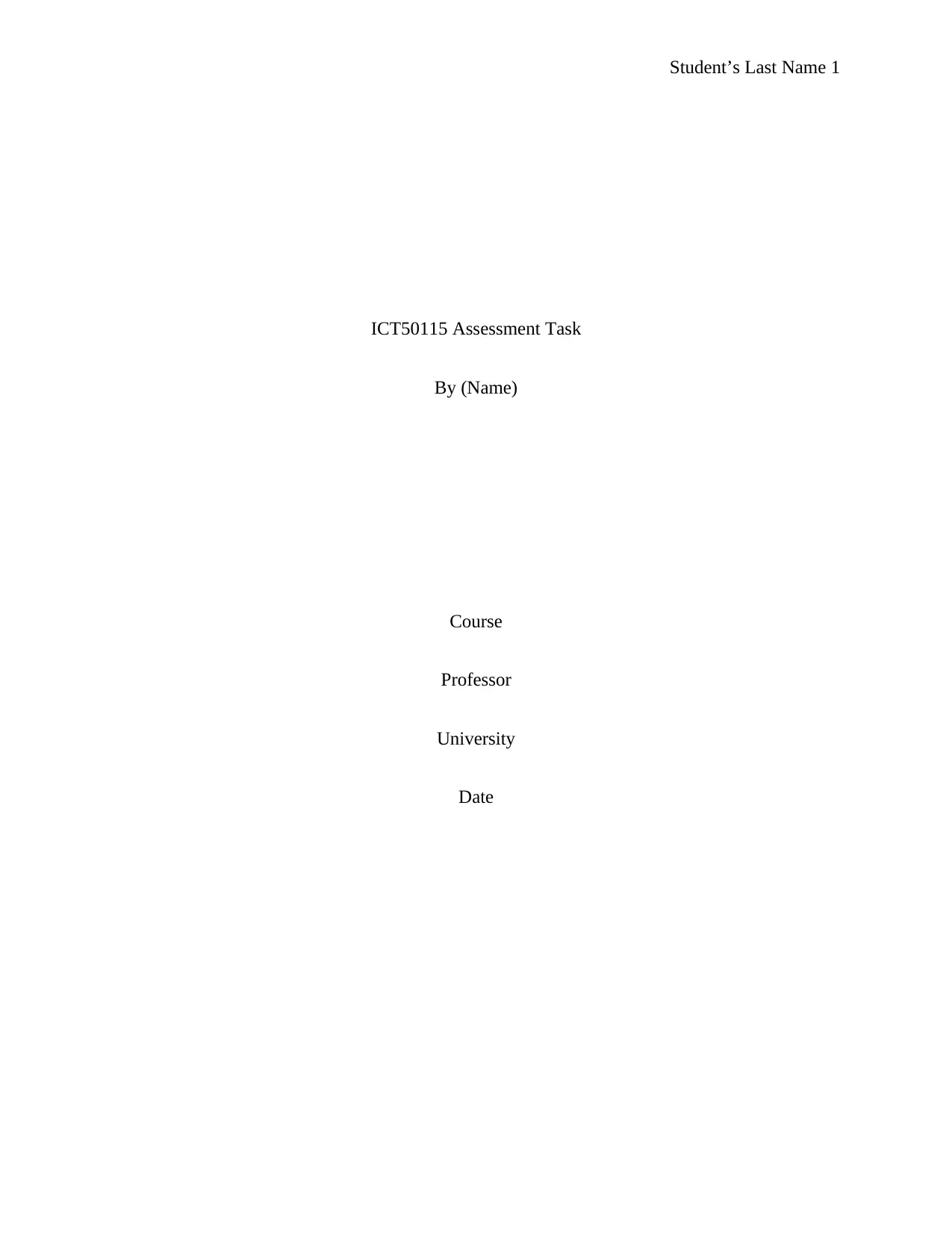
Student’s Last Name 1
ICT50115 Assessment Task
By (Name)
Course
Professor
University
Date
ICT50115 Assessment Task
By (Name)
Course
Professor
University
Date
Paraphrase This Document
Need a fresh take? Get an instant paraphrase of this document with our AI Paraphraser
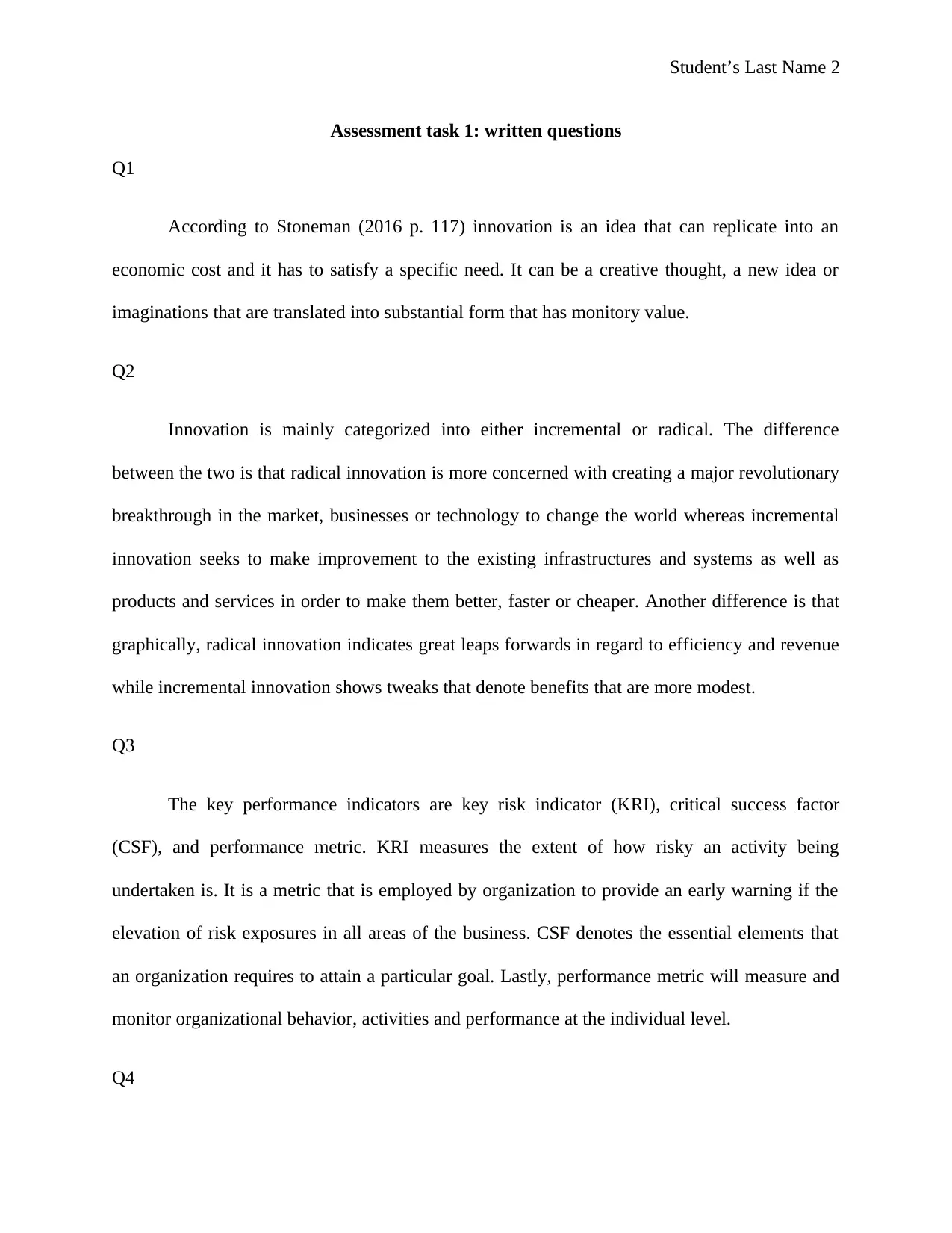
Student’s Last Name 2
Assessment task 1: written questions
Q1
According to Stoneman (2016 p. 117) innovation is an idea that can replicate into an
economic cost and it has to satisfy a specific need. It can be a creative thought, a new idea or
imaginations that are translated into substantial form that has monitory value.
Q2
Innovation is mainly categorized into either incremental or radical. The difference
between the two is that radical innovation is more concerned with creating a major revolutionary
breakthrough in the market, businesses or technology to change the world whereas incremental
innovation seeks to make improvement to the existing infrastructures and systems as well as
products and services in order to make them better, faster or cheaper. Another difference is that
graphically, radical innovation indicates great leaps forwards in regard to efficiency and revenue
while incremental innovation shows tweaks that denote benefits that are more modest.
Q3
The key performance indicators are key risk indicator (KRI), critical success factor
(CSF), and performance metric. KRI measures the extent of how risky an activity being
undertaken is. It is a metric that is employed by organization to provide an early warning if the
elevation of risk exposures in all areas of the business. CSF denotes the essential elements that
an organization requires to attain a particular goal. Lastly, performance metric will measure and
monitor organizational behavior, activities and performance at the individual level.
Q4
Assessment task 1: written questions
Q1
According to Stoneman (2016 p. 117) innovation is an idea that can replicate into an
economic cost and it has to satisfy a specific need. It can be a creative thought, a new idea or
imaginations that are translated into substantial form that has monitory value.
Q2
Innovation is mainly categorized into either incremental or radical. The difference
between the two is that radical innovation is more concerned with creating a major revolutionary
breakthrough in the market, businesses or technology to change the world whereas incremental
innovation seeks to make improvement to the existing infrastructures and systems as well as
products and services in order to make them better, faster or cheaper. Another difference is that
graphically, radical innovation indicates great leaps forwards in regard to efficiency and revenue
while incremental innovation shows tweaks that denote benefits that are more modest.
Q3
The key performance indicators are key risk indicator (KRI), critical success factor
(CSF), and performance metric. KRI measures the extent of how risky an activity being
undertaken is. It is a metric that is employed by organization to provide an early warning if the
elevation of risk exposures in all areas of the business. CSF denotes the essential elements that
an organization requires to attain a particular goal. Lastly, performance metric will measure and
monitor organizational behavior, activities and performance at the individual level.
Q4
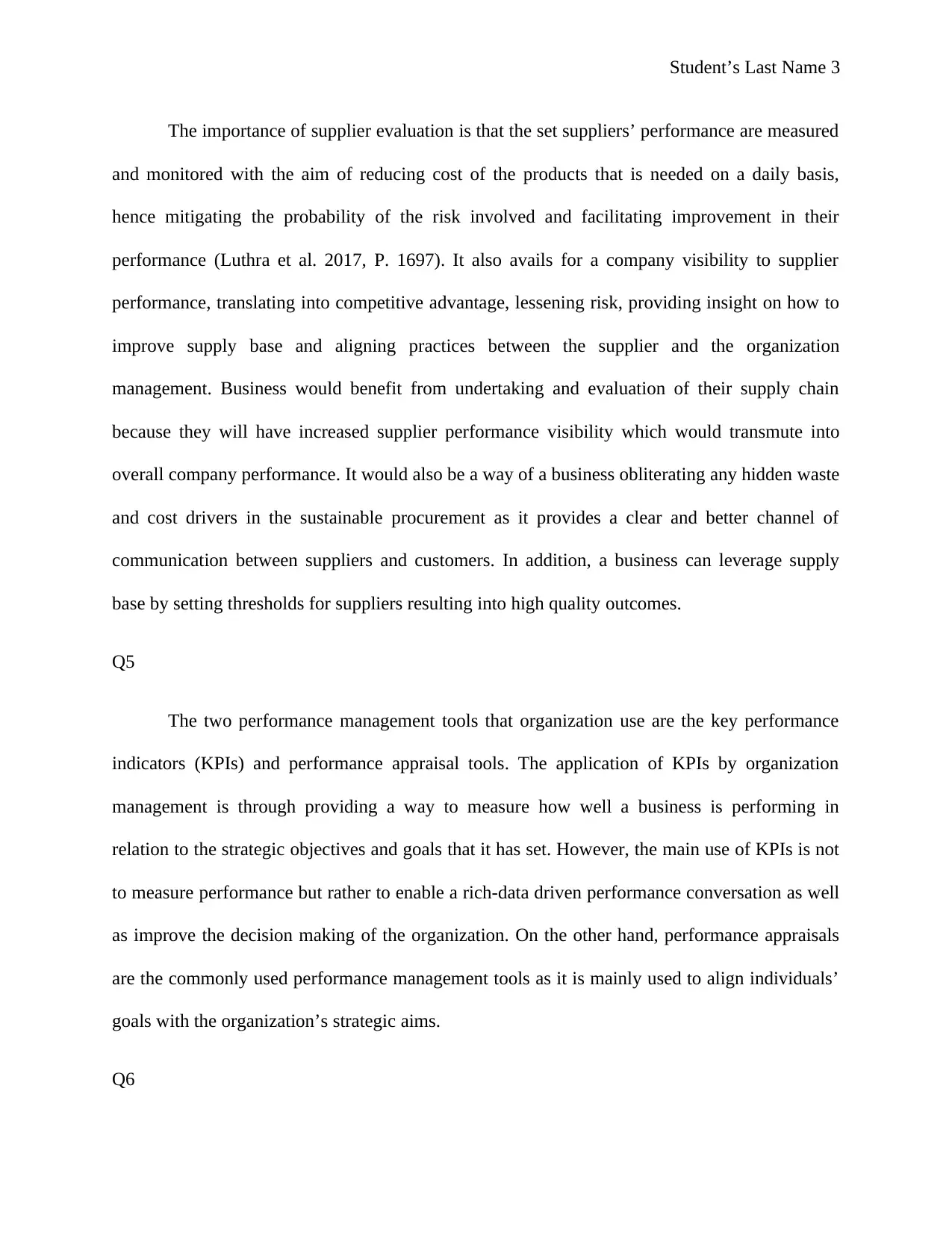
Student’s Last Name 3
The importance of supplier evaluation is that the set suppliers’ performance are measured
and monitored with the aim of reducing cost of the products that is needed on a daily basis,
hence mitigating the probability of the risk involved and facilitating improvement in their
performance (Luthra et al. 2017, P. 1697). It also avails for a company visibility to supplier
performance, translating into competitive advantage, lessening risk, providing insight on how to
improve supply base and aligning practices between the supplier and the organization
management. Business would benefit from undertaking and evaluation of their supply chain
because they will have increased supplier performance visibility which would transmute into
overall company performance. It would also be a way of a business obliterating any hidden waste
and cost drivers in the sustainable procurement as it provides a clear and better channel of
communication between suppliers and customers. In addition, a business can leverage supply
base by setting thresholds for suppliers resulting into high quality outcomes.
Q5
The two performance management tools that organization use are the key performance
indicators (KPIs) and performance appraisal tools. The application of KPIs by organization
management is through providing a way to measure how well a business is performing in
relation to the strategic objectives and goals that it has set. However, the main use of KPIs is not
to measure performance but rather to enable a rich-data driven performance conversation as well
as improve the decision making of the organization. On the other hand, performance appraisals
are the commonly used performance management tools as it is mainly used to align individuals’
goals with the organization’s strategic aims.
Q6
The importance of supplier evaluation is that the set suppliers’ performance are measured
and monitored with the aim of reducing cost of the products that is needed on a daily basis,
hence mitigating the probability of the risk involved and facilitating improvement in their
performance (Luthra et al. 2017, P. 1697). It also avails for a company visibility to supplier
performance, translating into competitive advantage, lessening risk, providing insight on how to
improve supply base and aligning practices between the supplier and the organization
management. Business would benefit from undertaking and evaluation of their supply chain
because they will have increased supplier performance visibility which would transmute into
overall company performance. It would also be a way of a business obliterating any hidden waste
and cost drivers in the sustainable procurement as it provides a clear and better channel of
communication between suppliers and customers. In addition, a business can leverage supply
base by setting thresholds for suppliers resulting into high quality outcomes.
Q5
The two performance management tools that organization use are the key performance
indicators (KPIs) and performance appraisal tools. The application of KPIs by organization
management is through providing a way to measure how well a business is performing in
relation to the strategic objectives and goals that it has set. However, the main use of KPIs is not
to measure performance but rather to enable a rich-data driven performance conversation as well
as improve the decision making of the organization. On the other hand, performance appraisals
are the commonly used performance management tools as it is mainly used to align individuals’
goals with the organization’s strategic aims.
Q6
⊘ This is a preview!⊘
Do you want full access?
Subscribe today to unlock all pages.

Trusted by 1+ million students worldwide
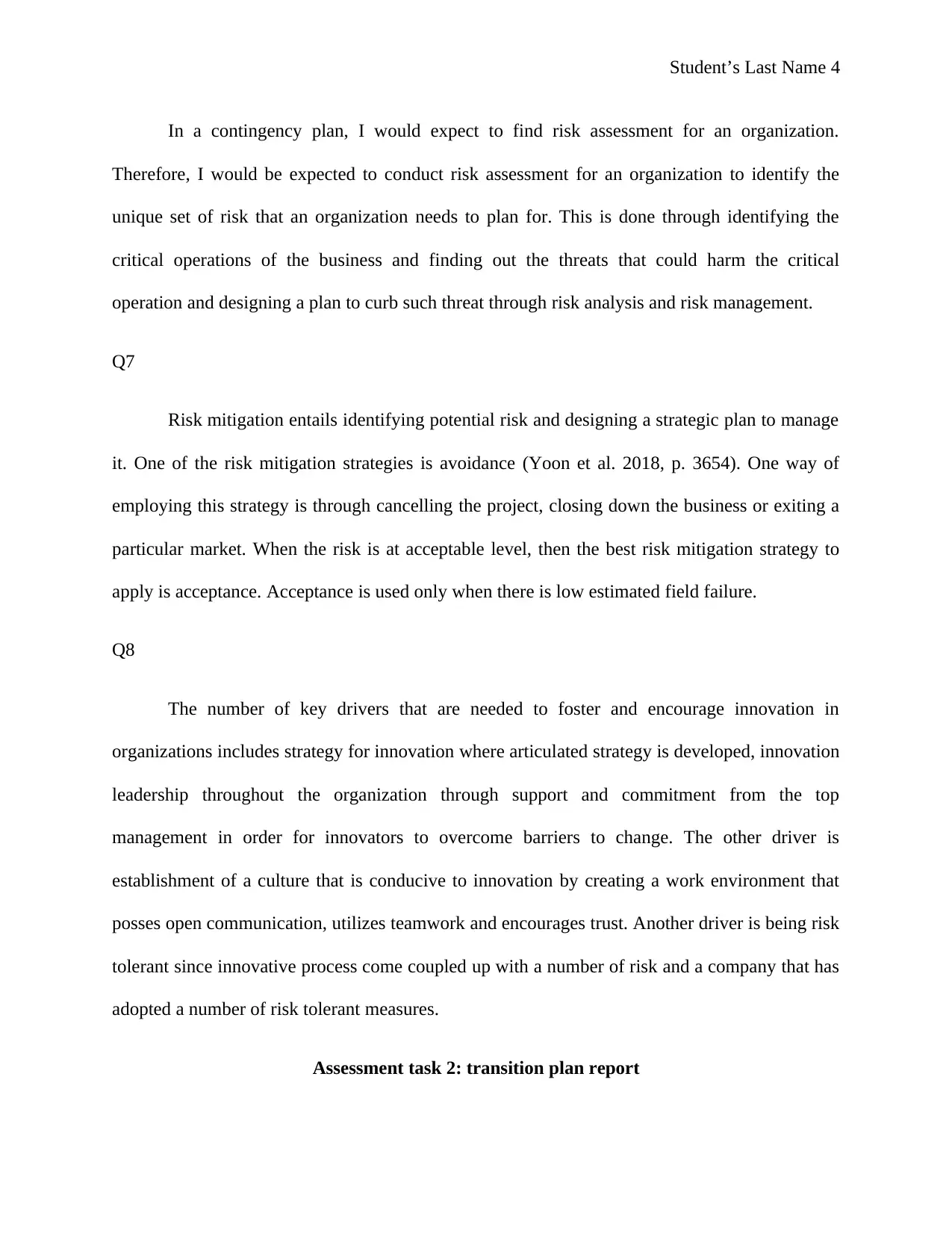
Student’s Last Name 4
In a contingency plan, I would expect to find risk assessment for an organization.
Therefore, I would be expected to conduct risk assessment for an organization to identify the
unique set of risk that an organization needs to plan for. This is done through identifying the
critical operations of the business and finding out the threats that could harm the critical
operation and designing a plan to curb such threat through risk analysis and risk management.
Q7
Risk mitigation entails identifying potential risk and designing a strategic plan to manage
it. One of the risk mitigation strategies is avoidance (Yoon et al. 2018, p. 3654). One way of
employing this strategy is through cancelling the project, closing down the business or exiting a
particular market. When the risk is at acceptable level, then the best risk mitigation strategy to
apply is acceptance. Acceptance is used only when there is low estimated field failure.
Q8
The number of key drivers that are needed to foster and encourage innovation in
organizations includes strategy for innovation where articulated strategy is developed, innovation
leadership throughout the organization through support and commitment from the top
management in order for innovators to overcome barriers to change. The other driver is
establishment of a culture that is conducive to innovation by creating a work environment that
posses open communication, utilizes teamwork and encourages trust. Another driver is being risk
tolerant since innovative process come coupled up with a number of risk and a company that has
adopted a number of risk tolerant measures.
Assessment task 2: transition plan report
In a contingency plan, I would expect to find risk assessment for an organization.
Therefore, I would be expected to conduct risk assessment for an organization to identify the
unique set of risk that an organization needs to plan for. This is done through identifying the
critical operations of the business and finding out the threats that could harm the critical
operation and designing a plan to curb such threat through risk analysis and risk management.
Q7
Risk mitigation entails identifying potential risk and designing a strategic plan to manage
it. One of the risk mitigation strategies is avoidance (Yoon et al. 2018, p. 3654). One way of
employing this strategy is through cancelling the project, closing down the business or exiting a
particular market. When the risk is at acceptable level, then the best risk mitigation strategy to
apply is acceptance. Acceptance is used only when there is low estimated field failure.
Q8
The number of key drivers that are needed to foster and encourage innovation in
organizations includes strategy for innovation where articulated strategy is developed, innovation
leadership throughout the organization through support and commitment from the top
management in order for innovators to overcome barriers to change. The other driver is
establishment of a culture that is conducive to innovation by creating a work environment that
posses open communication, utilizes teamwork and encourages trust. Another driver is being risk
tolerant since innovative process come coupled up with a number of risk and a company that has
adopted a number of risk tolerant measures.
Assessment task 2: transition plan report
Paraphrase This Document
Need a fresh take? Get an instant paraphrase of this document with our AI Paraphraser
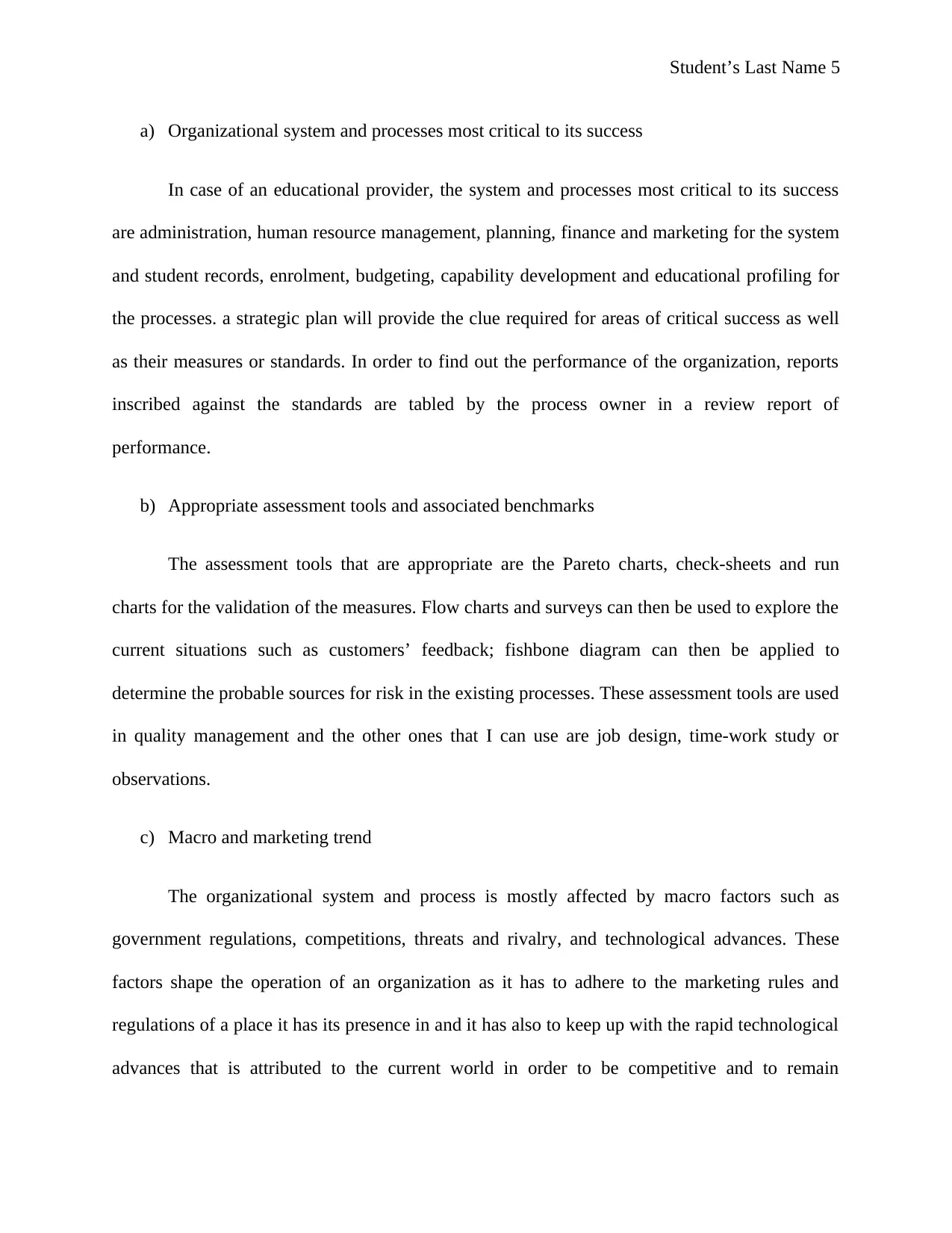
Student’s Last Name 5
a) Organizational system and processes most critical to its success
In case of an educational provider, the system and processes most critical to its success
are administration, human resource management, planning, finance and marketing for the system
and student records, enrolment, budgeting, capability development and educational profiling for
the processes. a strategic plan will provide the clue required for areas of critical success as well
as their measures or standards. In order to find out the performance of the organization, reports
inscribed against the standards are tabled by the process owner in a review report of
performance.
b) Appropriate assessment tools and associated benchmarks
The assessment tools that are appropriate are the Pareto charts, check-sheets and run
charts for the validation of the measures. Flow charts and surveys can then be used to explore the
current situations such as customers’ feedback; fishbone diagram can then be applied to
determine the probable sources for risk in the existing processes. These assessment tools are used
in quality management and the other ones that I can use are job design, time-work study or
observations.
c) Macro and marketing trend
The organizational system and process is mostly affected by macro factors such as
government regulations, competitions, threats and rivalry, and technological advances. These
factors shape the operation of an organization as it has to adhere to the marketing rules and
regulations of a place it has its presence in and it has also to keep up with the rapid technological
advances that is attributed to the current world in order to be competitive and to remain
a) Organizational system and processes most critical to its success
In case of an educational provider, the system and processes most critical to its success
are administration, human resource management, planning, finance and marketing for the system
and student records, enrolment, budgeting, capability development and educational profiling for
the processes. a strategic plan will provide the clue required for areas of critical success as well
as their measures or standards. In order to find out the performance of the organization, reports
inscribed against the standards are tabled by the process owner in a review report of
performance.
b) Appropriate assessment tools and associated benchmarks
The assessment tools that are appropriate are the Pareto charts, check-sheets and run
charts for the validation of the measures. Flow charts and surveys can then be used to explore the
current situations such as customers’ feedback; fishbone diagram can then be applied to
determine the probable sources for risk in the existing processes. These assessment tools are used
in quality management and the other ones that I can use are job design, time-work study or
observations.
c) Macro and marketing trend
The organizational system and process is mostly affected by macro factors such as
government regulations, competitions, threats and rivalry, and technological advances. These
factors shape the operation of an organization as it has to adhere to the marketing rules and
regulations of a place it has its presence in and it has also to keep up with the rapid technological
advances that is attributed to the current world in order to be competitive and to remain
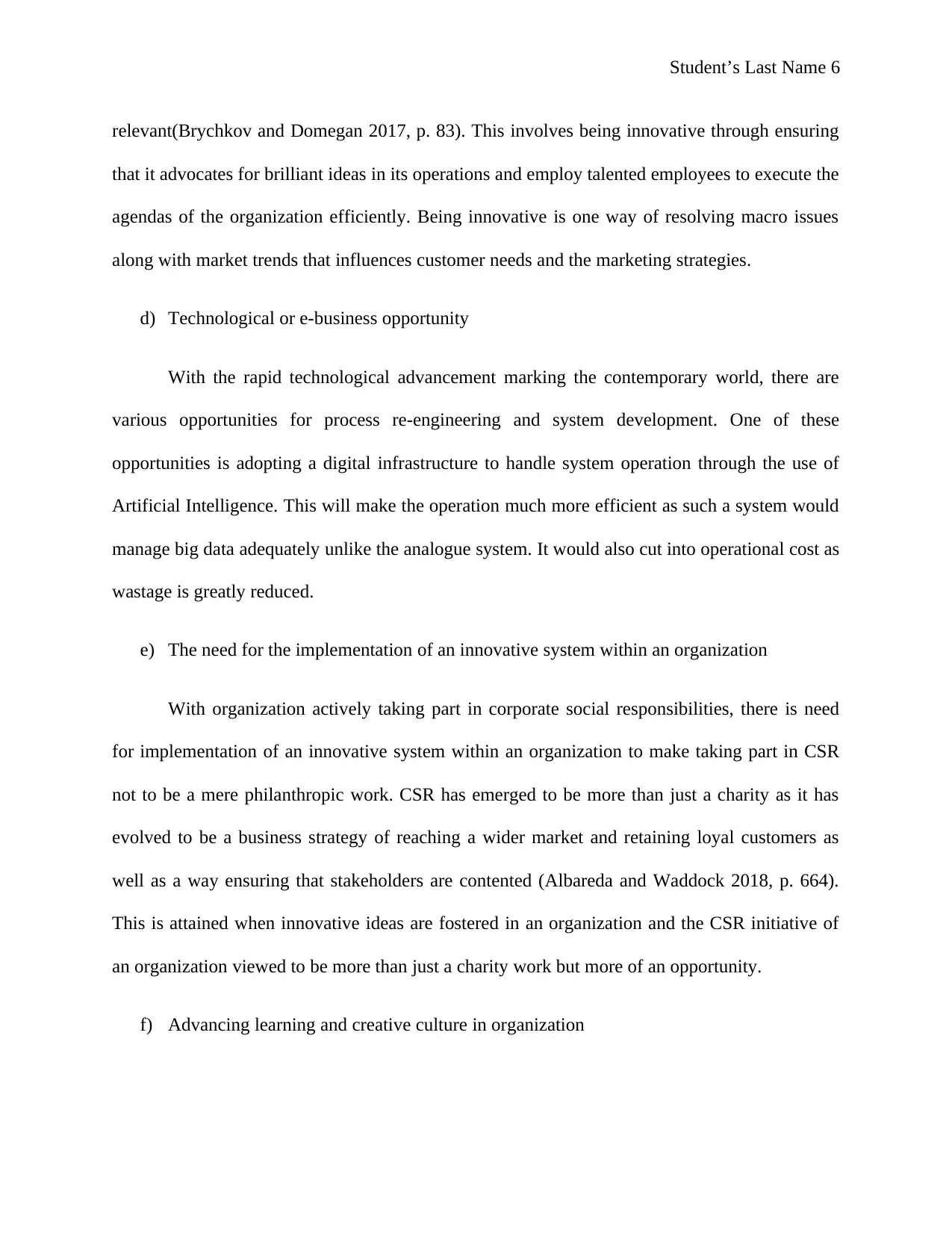
Student’s Last Name 6
relevant(Brychkov and Domegan 2017, p. 83). This involves being innovative through ensuring
that it advocates for brilliant ideas in its operations and employ talented employees to execute the
agendas of the organization efficiently. Being innovative is one way of resolving macro issues
along with market trends that influences customer needs and the marketing strategies.
d) Technological or e-business opportunity
With the rapid technological advancement marking the contemporary world, there are
various opportunities for process re-engineering and system development. One of these
opportunities is adopting a digital infrastructure to handle system operation through the use of
Artificial Intelligence. This will make the operation much more efficient as such a system would
manage big data adequately unlike the analogue system. It would also cut into operational cost as
wastage is greatly reduced.
e) The need for the implementation of an innovative system within an organization
With organization actively taking part in corporate social responsibilities, there is need
for implementation of an innovative system within an organization to make taking part in CSR
not to be a mere philanthropic work. CSR has emerged to be more than just a charity as it has
evolved to be a business strategy of reaching a wider market and retaining loyal customers as
well as a way ensuring that stakeholders are contented (Albareda and Waddock 2018, p. 664).
This is attained when innovative ideas are fostered in an organization and the CSR initiative of
an organization viewed to be more than just a charity work but more of an opportunity.
f) Advancing learning and creative culture in organization
relevant(Brychkov and Domegan 2017, p. 83). This involves being innovative through ensuring
that it advocates for brilliant ideas in its operations and employ talented employees to execute the
agendas of the organization efficiently. Being innovative is one way of resolving macro issues
along with market trends that influences customer needs and the marketing strategies.
d) Technological or e-business opportunity
With the rapid technological advancement marking the contemporary world, there are
various opportunities for process re-engineering and system development. One of these
opportunities is adopting a digital infrastructure to handle system operation through the use of
Artificial Intelligence. This will make the operation much more efficient as such a system would
manage big data adequately unlike the analogue system. It would also cut into operational cost as
wastage is greatly reduced.
e) The need for the implementation of an innovative system within an organization
With organization actively taking part in corporate social responsibilities, there is need
for implementation of an innovative system within an organization to make taking part in CSR
not to be a mere philanthropic work. CSR has emerged to be more than just a charity as it has
evolved to be a business strategy of reaching a wider market and retaining loyal customers as
well as a way ensuring that stakeholders are contented (Albareda and Waddock 2018, p. 664).
This is attained when innovative ideas are fostered in an organization and the CSR initiative of
an organization viewed to be more than just a charity work but more of an opportunity.
f) Advancing learning and creative culture in organization
⊘ This is a preview!⊘
Do you want full access?
Subscribe today to unlock all pages.

Trusted by 1+ million students worldwide
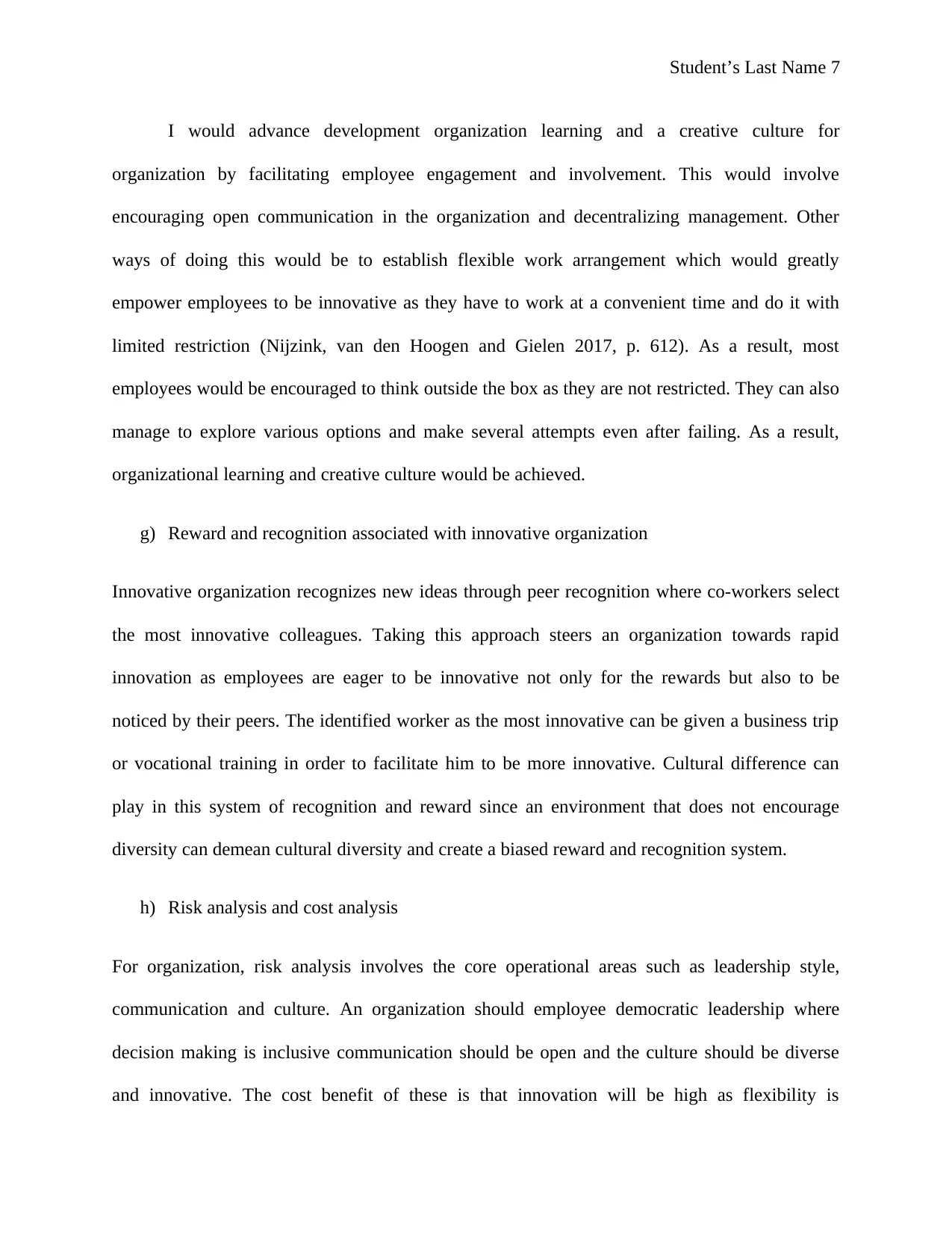
Student’s Last Name 7
I would advance development organization learning and a creative culture for
organization by facilitating employee engagement and involvement. This would involve
encouraging open communication in the organization and decentralizing management. Other
ways of doing this would be to establish flexible work arrangement which would greatly
empower employees to be innovative as they have to work at a convenient time and do it with
limited restriction (Nijzink, van den Hoogen and Gielen 2017, p. 612). As a result, most
employees would be encouraged to think outside the box as they are not restricted. They can also
manage to explore various options and make several attempts even after failing. As a result,
organizational learning and creative culture would be achieved.
g) Reward and recognition associated with innovative organization
Innovative organization recognizes new ideas through peer recognition where co-workers select
the most innovative colleagues. Taking this approach steers an organization towards rapid
innovation as employees are eager to be innovative not only for the rewards but also to be
noticed by their peers. The identified worker as the most innovative can be given a business trip
or vocational training in order to facilitate him to be more innovative. Cultural difference can
play in this system of recognition and reward since an environment that does not encourage
diversity can demean cultural diversity and create a biased reward and recognition system.
h) Risk analysis and cost analysis
For organization, risk analysis involves the core operational areas such as leadership style,
communication and culture. An organization should employee democratic leadership where
decision making is inclusive communication should be open and the culture should be diverse
and innovative. The cost benefit of these is that innovation will be high as flexibility is
I would advance development organization learning and a creative culture for
organization by facilitating employee engagement and involvement. This would involve
encouraging open communication in the organization and decentralizing management. Other
ways of doing this would be to establish flexible work arrangement which would greatly
empower employees to be innovative as they have to work at a convenient time and do it with
limited restriction (Nijzink, van den Hoogen and Gielen 2017, p. 612). As a result, most
employees would be encouraged to think outside the box as they are not restricted. They can also
manage to explore various options and make several attempts even after failing. As a result,
organizational learning and creative culture would be achieved.
g) Reward and recognition associated with innovative organization
Innovative organization recognizes new ideas through peer recognition where co-workers select
the most innovative colleagues. Taking this approach steers an organization towards rapid
innovation as employees are eager to be innovative not only for the rewards but also to be
noticed by their peers. The identified worker as the most innovative can be given a business trip
or vocational training in order to facilitate him to be more innovative. Cultural difference can
play in this system of recognition and reward since an environment that does not encourage
diversity can demean cultural diversity and create a biased reward and recognition system.
h) Risk analysis and cost analysis
For organization, risk analysis involves the core operational areas such as leadership style,
communication and culture. An organization should employee democratic leadership where
decision making is inclusive communication should be open and the culture should be diverse
and innovative. The cost benefit of these is that innovation will be high as flexibility is
Paraphrase This Document
Need a fresh take? Get an instant paraphrase of this document with our AI Paraphraser
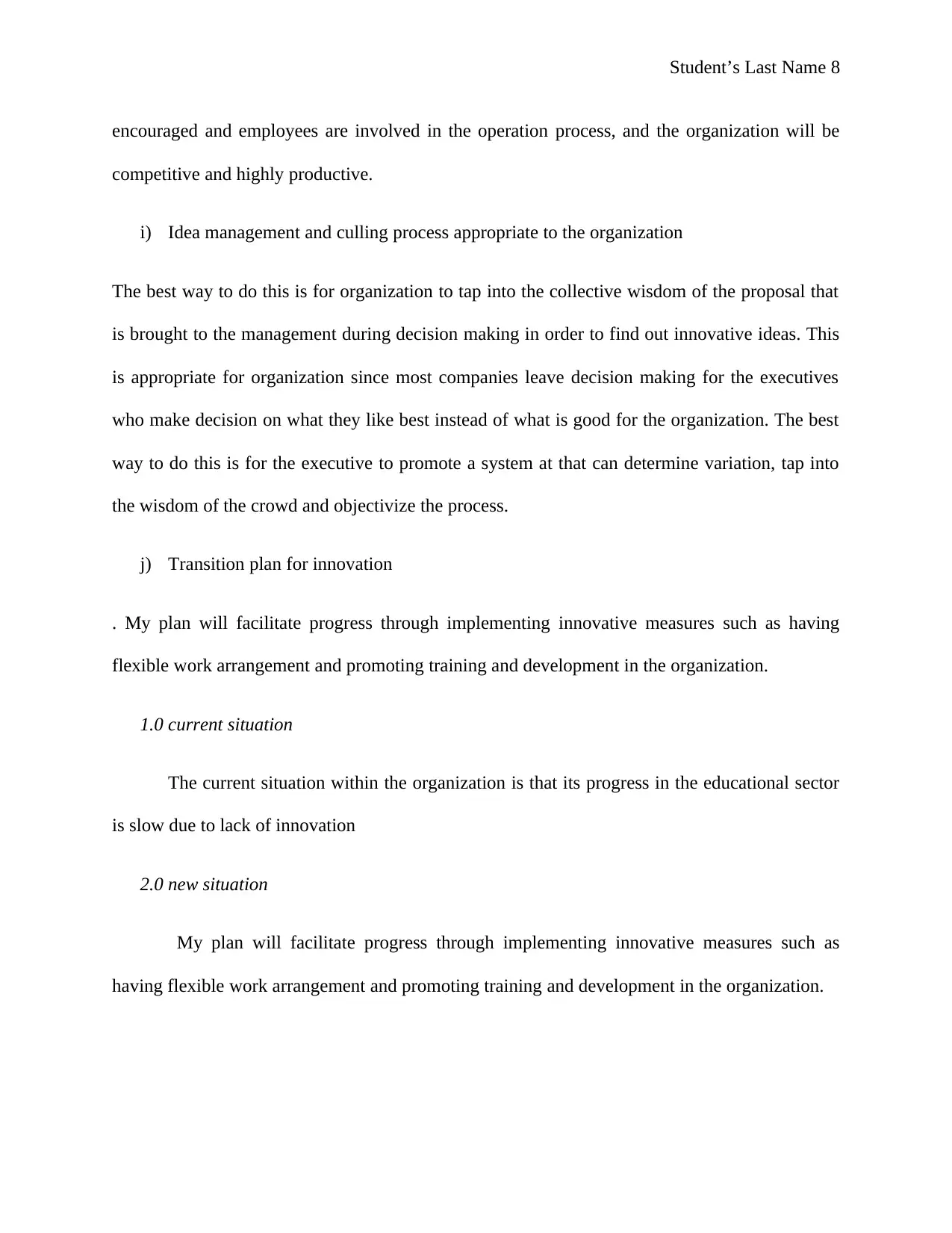
Student’s Last Name 8
encouraged and employees are involved in the operation process, and the organization will be
competitive and highly productive.
i) Idea management and culling process appropriate to the organization
The best way to do this is for organization to tap into the collective wisdom of the proposal that
is brought to the management during decision making in order to find out innovative ideas. This
is appropriate for organization since most companies leave decision making for the executives
who make decision on what they like best instead of what is good for the organization. The best
way to do this is for the executive to promote a system at that can determine variation, tap into
the wisdom of the crowd and objectivize the process.
j) Transition plan for innovation
. My plan will facilitate progress through implementing innovative measures such as having
flexible work arrangement and promoting training and development in the organization.
1.0 current situation
The current situation within the organization is that its progress in the educational sector
is slow due to lack of innovation
2.0 new situation
My plan will facilitate progress through implementing innovative measures such as
having flexible work arrangement and promoting training and development in the organization.
encouraged and employees are involved in the operation process, and the organization will be
competitive and highly productive.
i) Idea management and culling process appropriate to the organization
The best way to do this is for organization to tap into the collective wisdom of the proposal that
is brought to the management during decision making in order to find out innovative ideas. This
is appropriate for organization since most companies leave decision making for the executives
who make decision on what they like best instead of what is good for the organization. The best
way to do this is for the executive to promote a system at that can determine variation, tap into
the wisdom of the crowd and objectivize the process.
j) Transition plan for innovation
. My plan will facilitate progress through implementing innovative measures such as having
flexible work arrangement and promoting training and development in the organization.
1.0 current situation
The current situation within the organization is that its progress in the educational sector
is slow due to lack of innovation
2.0 new situation
My plan will facilitate progress through implementing innovative measures such as
having flexible work arrangement and promoting training and development in the organization.
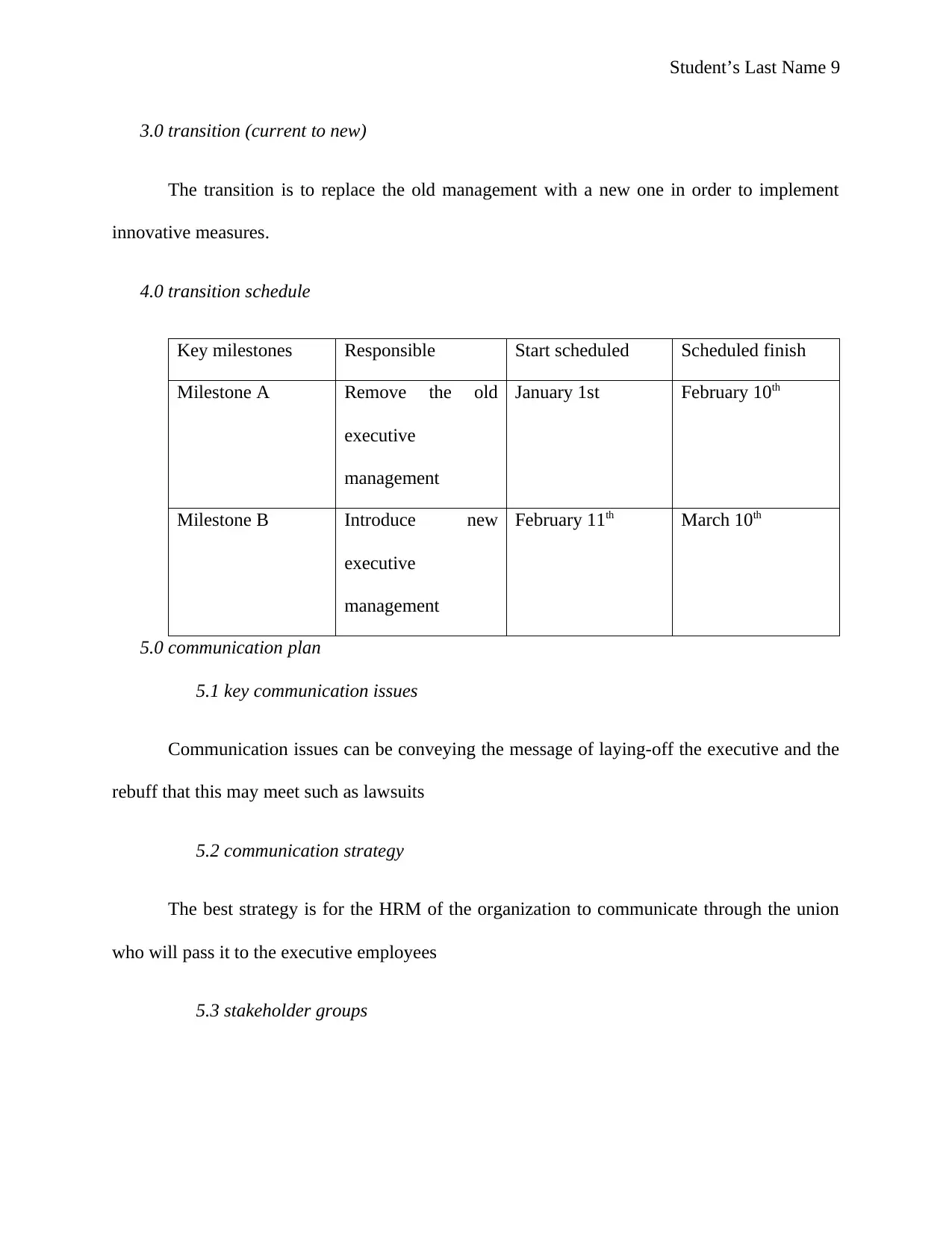
Student’s Last Name 9
3.0 transition (current to new)
The transition is to replace the old management with a new one in order to implement
innovative measures.
4.0 transition schedule
Key milestones Responsible Start scheduled Scheduled finish
Milestone A Remove the old
executive
management
January 1st February 10th
Milestone B Introduce new
executive
management
February 11th March 10th
5.0 communication plan
5.1 key communication issues
Communication issues can be conveying the message of laying-off the executive and the
rebuff that this may meet such as lawsuits
5.2 communication strategy
The best strategy is for the HRM of the organization to communicate through the union
who will pass it to the executive employees
5.3 stakeholder groups
3.0 transition (current to new)
The transition is to replace the old management with a new one in order to implement
innovative measures.
4.0 transition schedule
Key milestones Responsible Start scheduled Scheduled finish
Milestone A Remove the old
executive
management
January 1st February 10th
Milestone B Introduce new
executive
management
February 11th March 10th
5.0 communication plan
5.1 key communication issues
Communication issues can be conveying the message of laying-off the executive and the
rebuff that this may meet such as lawsuits
5.2 communication strategy
The best strategy is for the HRM of the organization to communicate through the union
who will pass it to the executive employees
5.3 stakeholder groups
⊘ This is a preview!⊘
Do you want full access?
Subscribe today to unlock all pages.

Trusted by 1+ million students worldwide
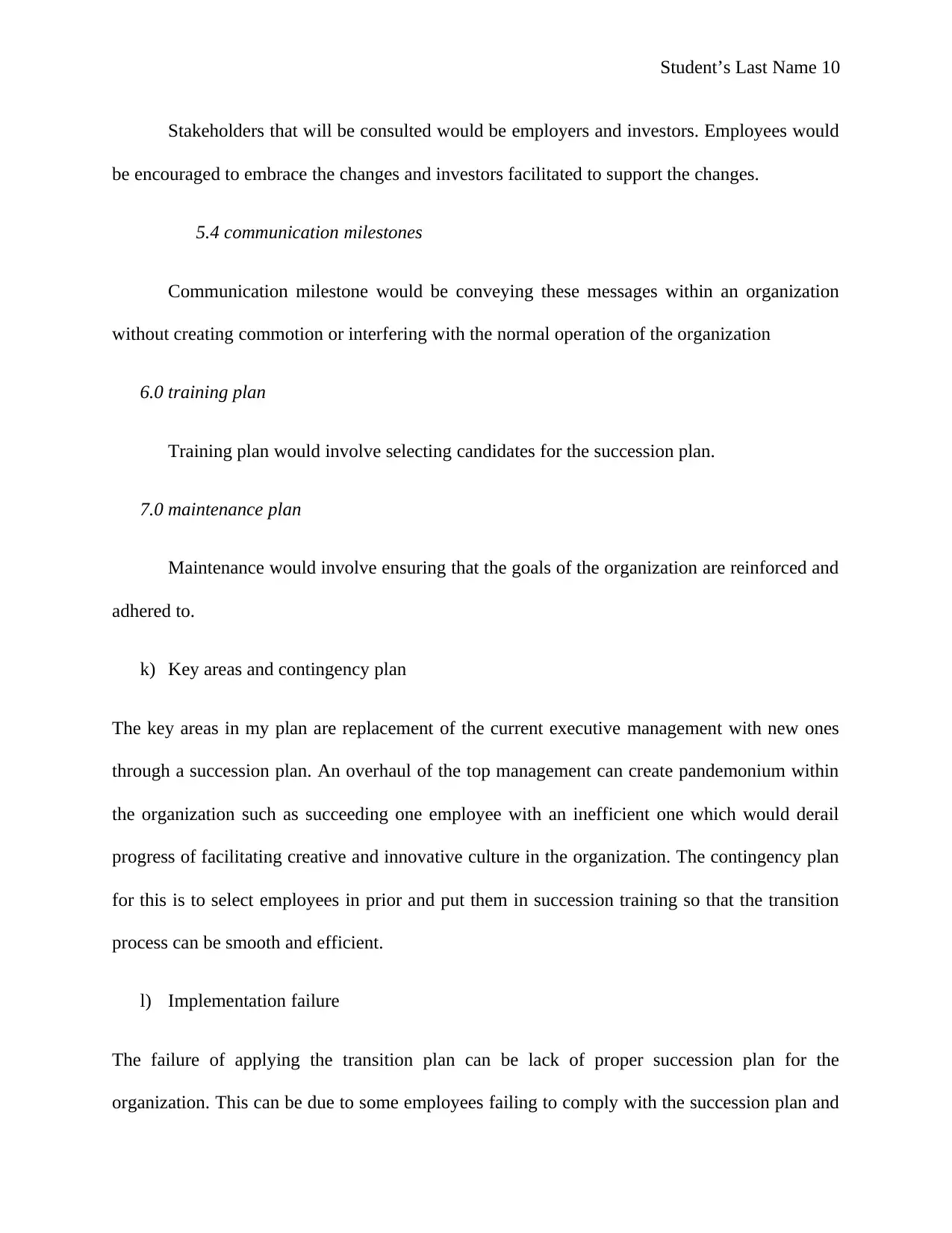
Student’s Last Name 10
Stakeholders that will be consulted would be employers and investors. Employees would
be encouraged to embrace the changes and investors facilitated to support the changes.
5.4 communication milestones
Communication milestone would be conveying these messages within an organization
without creating commotion or interfering with the normal operation of the organization
6.0 training plan
Training plan would involve selecting candidates for the succession plan.
7.0 maintenance plan
Maintenance would involve ensuring that the goals of the organization are reinforced and
adhered to.
k) Key areas and contingency plan
The key areas in my plan are replacement of the current executive management with new ones
through a succession plan. An overhaul of the top management can create pandemonium within
the organization such as succeeding one employee with an inefficient one which would derail
progress of facilitating creative and innovative culture in the organization. The contingency plan
for this is to select employees in prior and put them in succession training so that the transition
process can be smooth and efficient.
l) Implementation failure
The failure of applying the transition plan can be lack of proper succession plan for the
organization. This can be due to some employees failing to comply with the succession plan and
Stakeholders that will be consulted would be employers and investors. Employees would
be encouraged to embrace the changes and investors facilitated to support the changes.
5.4 communication milestones
Communication milestone would be conveying these messages within an organization
without creating commotion or interfering with the normal operation of the organization
6.0 training plan
Training plan would involve selecting candidates for the succession plan.
7.0 maintenance plan
Maintenance would involve ensuring that the goals of the organization are reinforced and
adhered to.
k) Key areas and contingency plan
The key areas in my plan are replacement of the current executive management with new ones
through a succession plan. An overhaul of the top management can create pandemonium within
the organization such as succeeding one employee with an inefficient one which would derail
progress of facilitating creative and innovative culture in the organization. The contingency plan
for this is to select employees in prior and put them in succession training so that the transition
process can be smooth and efficient.
l) Implementation failure
The failure of applying the transition plan can be lack of proper succession plan for the
organization. This can be due to some employees failing to comply with the succession plan and
Paraphrase This Document
Need a fresh take? Get an instant paraphrase of this document with our AI Paraphraser
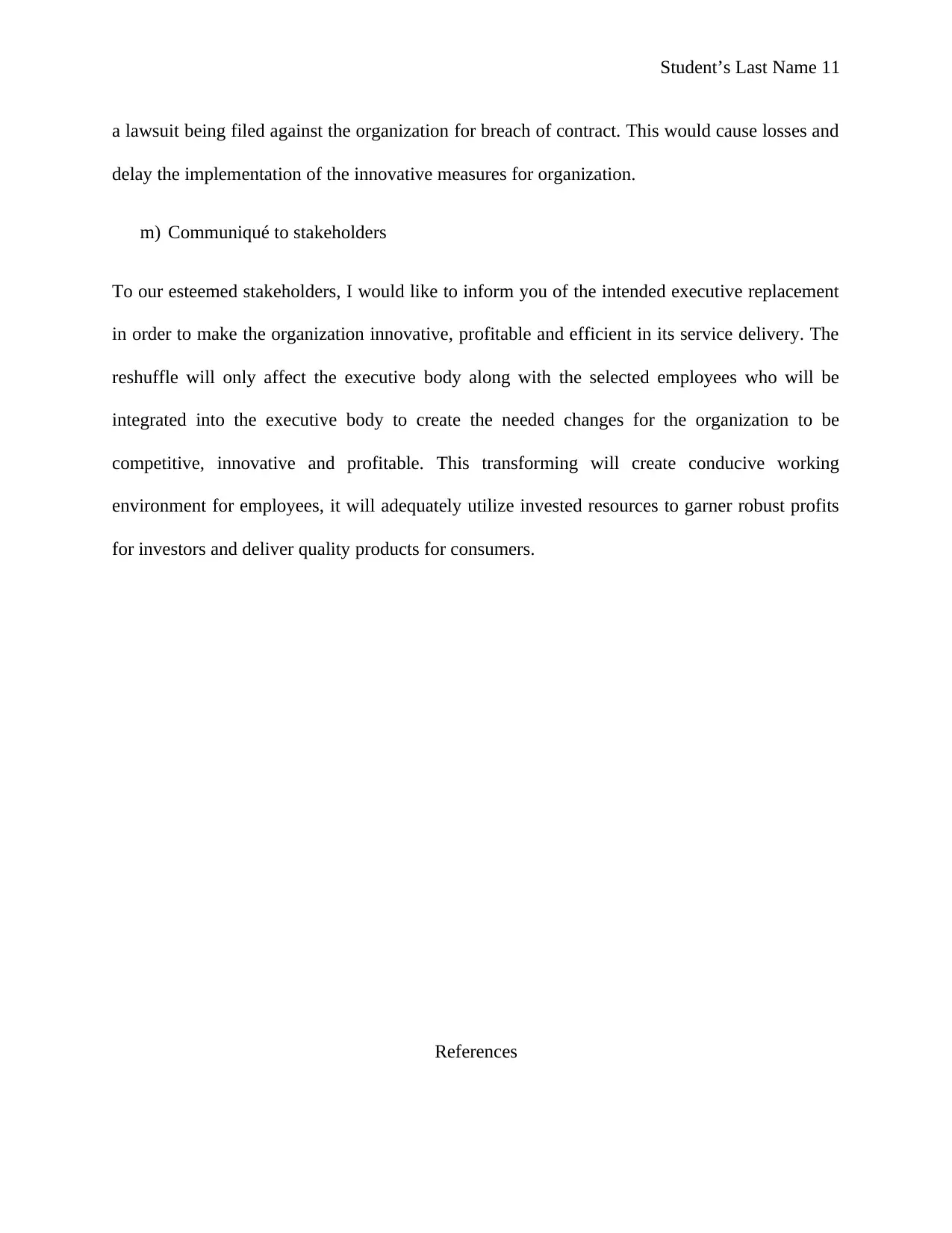
Student’s Last Name 11
a lawsuit being filed against the organization for breach of contract. This would cause losses and
delay the implementation of the innovative measures for organization.
m) Communiqué to stakeholders
To our esteemed stakeholders, I would like to inform you of the intended executive replacement
in order to make the organization innovative, profitable and efficient in its service delivery. The
reshuffle will only affect the executive body along with the selected employees who will be
integrated into the executive body to create the needed changes for the organization to be
competitive, innovative and profitable. This transforming will create conducive working
environment for employees, it will adequately utilize invested resources to garner robust profits
for investors and deliver quality products for consumers.
References
a lawsuit being filed against the organization for breach of contract. This would cause losses and
delay the implementation of the innovative measures for organization.
m) Communiqué to stakeholders
To our esteemed stakeholders, I would like to inform you of the intended executive replacement
in order to make the organization innovative, profitable and efficient in its service delivery. The
reshuffle will only affect the executive body along with the selected employees who will be
integrated into the executive body to create the needed changes for the organization to be
competitive, innovative and profitable. This transforming will create conducive working
environment for employees, it will adequately utilize invested resources to garner robust profits
for investors and deliver quality products for consumers.
References
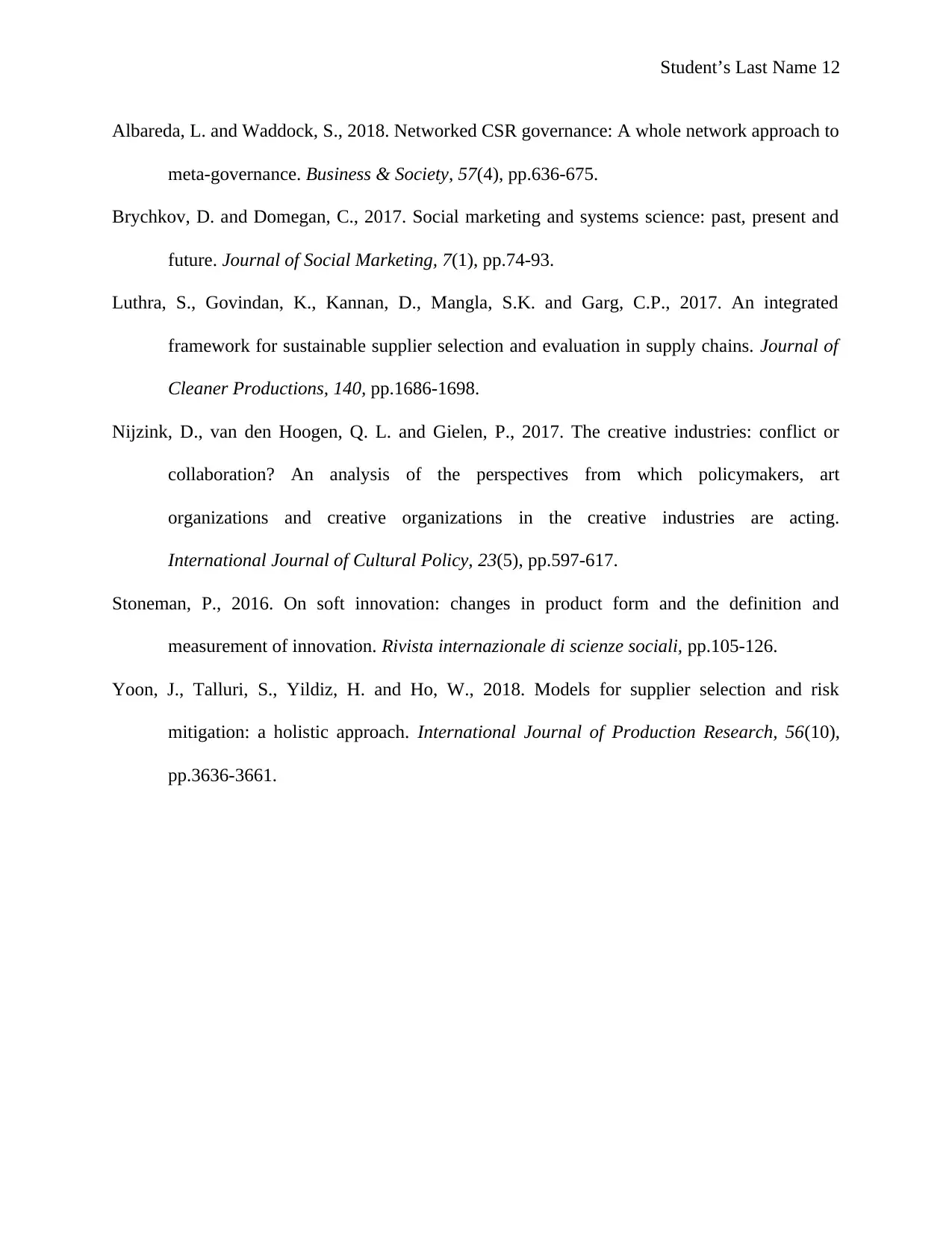
Student’s Last Name 12
Albareda, L. and Waddock, S., 2018. Networked CSR governance: A whole network approach to
meta-governance. Business & Society, 57(4), pp.636-675.
Brychkov, D. and Domegan, C., 2017. Social marketing and systems science: past, present and
future. Journal of Social Marketing, 7(1), pp.74-93.
Luthra, S., Govindan, K., Kannan, D., Mangla, S.K. and Garg, C.P., 2017. An integrated
framework for sustainable supplier selection and evaluation in supply chains. Journal of
Cleaner Productions, 140, pp.1686-1698.
Nijzink, D., van den Hoogen, Q. L. and Gielen, P., 2017. The creative industries: conflict or
collaboration? An analysis of the perspectives from which policymakers, art
organizations and creative organizations in the creative industries are acting.
International Journal of Cultural Policy, 23(5), pp.597-617.
Stoneman, P., 2016. On soft innovation: changes in product form and the definition and
measurement of innovation. Rivista internazionale di scienze sociali, pp.105-126.
Yoon, J., Talluri, S., Yildiz, H. and Ho, W., 2018. Models for supplier selection and risk
mitigation: a holistic approach. International Journal of Production Research, 56(10),
pp.3636-3661.
Albareda, L. and Waddock, S., 2018. Networked CSR governance: A whole network approach to
meta-governance. Business & Society, 57(4), pp.636-675.
Brychkov, D. and Domegan, C., 2017. Social marketing and systems science: past, present and
future. Journal of Social Marketing, 7(1), pp.74-93.
Luthra, S., Govindan, K., Kannan, D., Mangla, S.K. and Garg, C.P., 2017. An integrated
framework for sustainable supplier selection and evaluation in supply chains. Journal of
Cleaner Productions, 140, pp.1686-1698.
Nijzink, D., van den Hoogen, Q. L. and Gielen, P., 2017. The creative industries: conflict or
collaboration? An analysis of the perspectives from which policymakers, art
organizations and creative organizations in the creative industries are acting.
International Journal of Cultural Policy, 23(5), pp.597-617.
Stoneman, P., 2016. On soft innovation: changes in product form and the definition and
measurement of innovation. Rivista internazionale di scienze sociali, pp.105-126.
Yoon, J., Talluri, S., Yildiz, H. and Ho, W., 2018. Models for supplier selection and risk
mitigation: a holistic approach. International Journal of Production Research, 56(10),
pp.3636-3661.
⊘ This is a preview!⊘
Do you want full access?
Subscribe today to unlock all pages.

Trusted by 1+ million students worldwide
1 out of 12
Related Documents
Your All-in-One AI-Powered Toolkit for Academic Success.
+13062052269
info@desklib.com
Available 24*7 on WhatsApp / Email
![[object Object]](/_next/static/media/star-bottom.7253800d.svg)
Unlock your academic potential
Copyright © 2020–2025 A2Z Services. All Rights Reserved. Developed and managed by ZUCOL.





